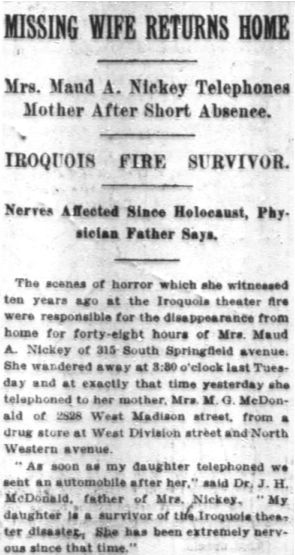|
Twenty-four-year-old Maud A. MacDonald Nickey
(1879–) survived the Iroquois Theater fire and
testified about her experience at the coroner's
trial, her testimony appearing in newspapers around
the country.
Maud attended the theater by herself, one of
only a handful of solo theater goers that day.
Her seat was in the tenth row of the orchestra. She
saw the flames starting in the scenery but did not
get out of her seat until the heat became intense
and people around her began to faint. Then she ran,
first toward the rear and then toward the burning
stage, but finally was attracted by the breaking of
the glass at the window [fire escape]. A man was
there trying to force open the iron door over the
window, and scores were crowding that way. The
window was tightly bolted or blocked and would not
loosen readily. All the time they were trying to
force it, people were falling and being burned to
death.
"When the iron door swung open, and the cold air
rushed in, there was a mad rush. Mrs. Nickey
jumped to the ground, falling on people and with
other persons falling on her. Her hair had been
singed, and she was almost exhausted from shock.
A boy jumped from an upper window and nearly
killed her.
|

|
"The distance from the lower windows to the
ground in the alley was only a few feet and had
they been easily opened, many others might have
escaped, Mrs. Nickey declared.
Maud's husband was Frank
Andrew Nickey (1880–1958), who became a
traveling salesman and managed a Japanese gift
importing company. Maud was one of six children
born to Dr. John C. MacDonald (1855–) and Marie
Greer MacDonald (1859–1938). Marie taught piano
and ventriloquism and John was president of the
Chicago Musical Seminary. The Seminimary
was located at Steinway Hall at 17 Van Buren in
Chicago. It boasted of having 19 teachers
giving lessons in ventriloquism, artistic
whistling, voice culture, piano, banjo, mandolin
and guitar.
|
|

|
In the years after the fire
A decade after the Iroquois Theater fire, Maud still
suffered from what today might be diagnosed as PTSD. In October, 1913,
she disappeared for two days and authorities were concerned that she may have met with
foul play, as had two other Chicago women that September and October.
Ida Leegson was a University of Chicago student lured by telephone to an
employment interview, then strangled. Mildred Rexroat was shot and killed after
being lured to a rural area. There was talk of dragging the lagoon in Garfield park
to look for Maud (why that particular lagoon was targeted was not reported)
but 48 hours later Maud telephoned her parents and they retrieved her from a
fruit store.
When she went missing in 1913 she was described
as "5 feet 3 inches tall, weighs 130 pounds,
blue eyes, blonde hair and prominent nose and
chin. She wore a blue dress with white dots,
brown sweater coat, long black velvet coat,
black velvet hat with ostrich plumes and black
shoes and black silk stockings.
|
